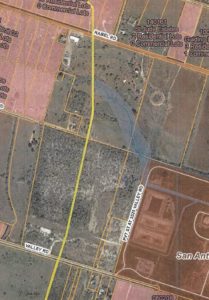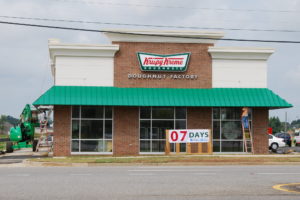I had a weird thing happen to me recently that prompted thoughts on real estate investing, “eminent domain,” and BIG GUBMINT.
I (re-)learned that what you don’t know might hurt you, and also what you think you know about your constitutional rights might not be true.
Through a series of unfortunate events, I became a one-fifth owner in a parcel of agricultural land in Southeast Bexar County, Texas.[1] I’ve been trying to sell it ever since. I have areas of investment expertise, but real estate development isn’t one of them. Which is probably why I found myself in this awkward spot.
Major Thoroughfares
Last fall I learned from our realtor that a 50-acre parcel of which I am a part-owner has a planned “Major Thoroughfare” running through the middle of it.
My realtor sent me the city parcel map and yup, there’s a bright yellow line cutting right through our property. As owners we can’t build on that. Any development done on the property has to make way for a future, theoretical, 120-foot wide road right down the middle.

Art Reinhardt, Assistant Director in the Transportation Department for the city of San Antonio explained to me that in 1978 – and then periodically updated afterwards – the City of San Antonio mapped out future theoretical roads, to account for growth.
The long-planned major thoroughfare is not built yet, and might not be built for decades, or even built at all, ever. But in the meantime, we can’t use that land for anything except a road.
All-in, the as yet non-existent “major thoroughfare” will take about five acres out of the parcel and make it unavailable for building. Multiply those five acres times the cost per acre, and we’re talking about real money lost by myself and my fellow owners.
At first, I thought the carved-out five acres would be no big deal. Because, well, I’m an American. And I was flipping through my copy of the US Constitution, as one does in one’s free time, and I re-read Article V of the Bill of Rights: “Nor shall any person…be deprived of life, liberty, or property, without due process of law; nor shall private property be taken for public use, without just compensation.”
This amendment is the basis for limitations on any government – city, state or federal – claiming “eminent domain” over private property, taking it for public use without paying the private property owner for that taking.
So no problem, I thought, the City of San Antonio will certainly pay us for that public use, right? I mean, I read it right there in the Fifth Amendment of the US Constitution. So, cool, I’m good.
That’s when I called city officials to test my theory.
Nope. There will be no compensation. I checked with multiple city officials familiar with this type of matter in the Planning, Transportation, and Office of Legal Counsel.
I further learned that even if an un-built but planned major thoroughfare exists, it will not show up in a title search, the typical due diligence step real estate purchasers use to be certain they have full to ownership with no liens or counter-claims from anyone, like an unpaid creditor or previous owner.
It seems the only practical way a buyer would know about this is through hiring a specialist attorney familiar with maps showing city plans for major thoroughfares. Something we clearly hadn’t done.
I talked to San Antonio attorney David Denton, a specialist in eminent domain and governmental real estate issues. He helped walk me through the legal particulars that would define an “eminent domain” case versus a “tough luck, private property owner” case.
Cities and other government entities obviously have rights and the need to restrict private usage through zoning, parcel platting, infrastructure requirements, and transportation. These may be considered ‘exactions’ imposed by a city government.
In legaleze, getting paid for eminent domain reasons hinges on whether there’s an ‘exaction’ (no compensation for the private land-owner) or a ‘taking’ (possible compensation for the private landowner.) Exactions provide government cover for a variety of legitimate uses, including it seems, future theoretical road access on this property. Denton also mentioned case law around the “proportionality” of the government’s requirements. I understand that to mean that if a higher proportion of a full property value was lost, it might start to resemble a ‘taking,’ but my situation didn’t rise to that level.
Lessons
One lesson, obviously, is don’t get into investing in things without really knowing what you’re doing. In other words, do as I say, not as I do.
Another lesson, more subtly, is that the world of real estate is not as simple as a bright line between private property rights and public or government property rights. We rarely can do precisely what we want with private land, and the public interest can impinge upon our theoretical property rights.

The third lesson I learned along the way is that BIG GUBMINT can be serendipitously profitable. It turns out there’s private silver lining opportunity in this public impingement. As a developer buddy of mine explained, some investors seek out land like this, with a major thoroughfare plan running through it.
Here’s why. If the major thoroughfare did get built soon, I’d be sitting on a potential gold-mine (a very small-scale gold-mine, but still). Suddenly my rural land would become far more valuable from the expected increase in automobile traffic. I could lease it out to a Krispy Kreme or whatever fast food joint would build a store next to the major roadway cutting through the property.
Actually, who am I kidding? If we could lease to Krispy Kreme specifically, I would move into a trailer next door and never leave. I love that sugary goodness.
[1] I wrote once about my star-crossed real estate investment a while back, as it gave me insight into the “Agricultural Exemption” game that developers play, in which they run a cow over their land once a year at tax inspection time and the county collects only a tiny fraction of the land’s market value.
A version of this post ran in the San Antonio Express News and Houston Chronicle.
Please see related posts:
A real estate rant about “agricultural” exemptions
Post read (203) times.




